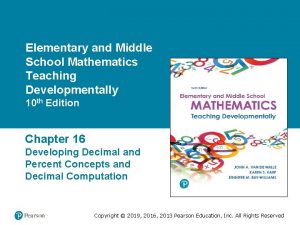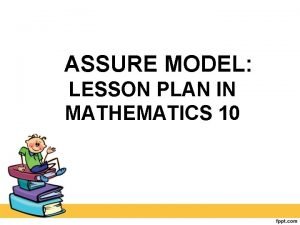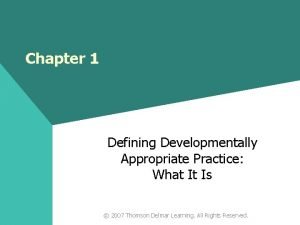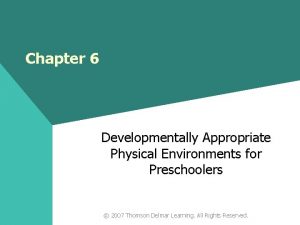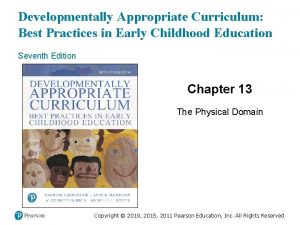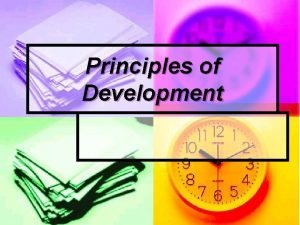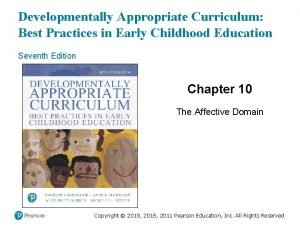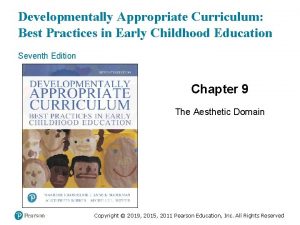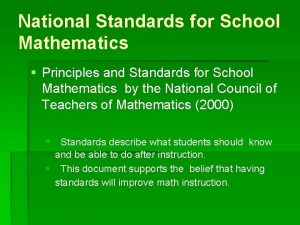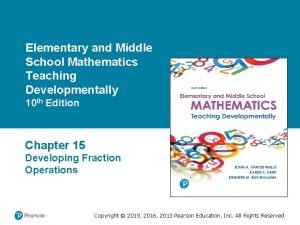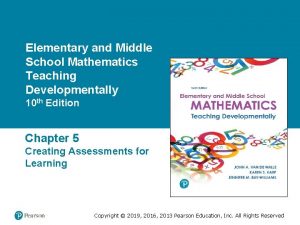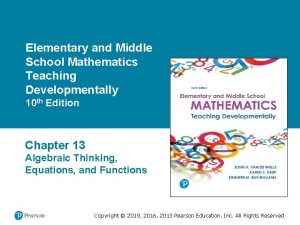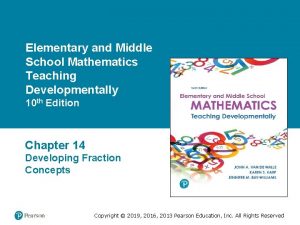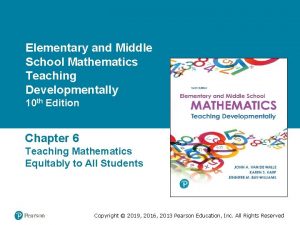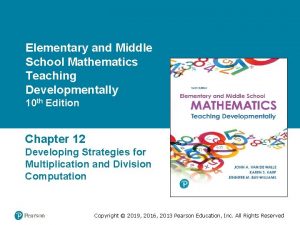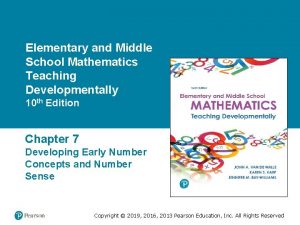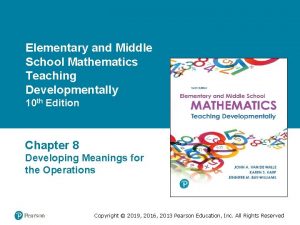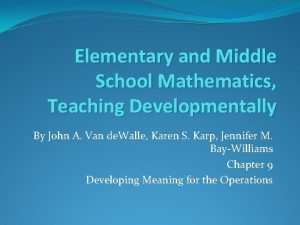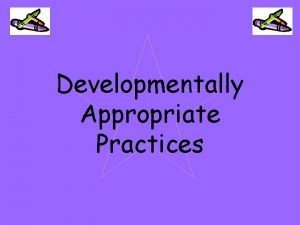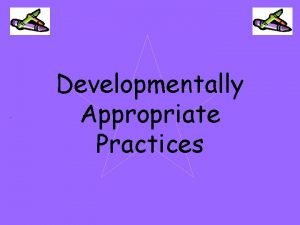Elementary and Middle School Mathematics Teaching Developmentally 10





















- Slides: 21

Elementary and Middle School Mathematics Teaching Developmentally 10 th Edition Chapter 16 Developing Decimal and Percent Concepts and Decimal Computation Copyright © 2019, 2016, 2013 Pearson Education, Inc. All Rights Reserved

Learner Outcomes 16. 1 Describe how the place-value system is central to the understanding of decimal fractions. 16. 2 Identify physical models that connect fractions to decimals. 16. 3 Demonstrate how to compare and order decimal fractions. 16. 4 Explain multiple strategies for computing with decimals. 16. 5 Explain how percents are related to fractions and decimals. Copyright © 2019, 2016, 2013 Pearson Education, Inc. All Rights Reserved

Standards-Based Development Grade 4: Develop an understanding of decimal notation (to hundredths) for fractions and compare decimal fractions. Grade 5: Perform operations with decimals (to hundredths), expanding comparisons of decimals to thousandths, and rounding decimals. Grade 6: Extend decimal operations beyond tenths and hundredths to all decimals, develop standard algorithms for all four decimal operations and explore percent of a quantity as a rate. Grade 7: Develop a “unified understanding of number” to be able to move fluently between decimals, fractions, and percents. Copyright © 2019, 2016, 2013 Pearson Education, Inc. All Rights Reserved

10 -to-1 Relationship - Now in Two Directions Copyright © 2019, 2016, 2013 Pearson Education, Inc. All Rights Reserved

Role of the Decimal Point Placement of the decimal point indicates the position of the unit. The decimal point always looks up at the name of the units position. Copyright © 2019, 2016, 2013 Pearson Education, Inc. All Rights Reserved

Precision and Equivalence Mathematically proficient students express numerical answers with a degree of precision appropriate for the problem context. Consider two measurements: 0. 06 and 0. 060 - Which one communicates a greater level of precision? When would that level of precision be important? Copyright © 2019, 2016, 2013 Pearson Education, Inc. All Rights Reserved

Connecting Fractions and Decimals Say decimals correctly, E. g. , 5. 2 is “five and two tenths” not “five point two”. Translation of a fraction to a decimal using models. Visual models for decimal fractions Copyright © 2019, 2016, 2013 Pearson Education, Inc. All Rights Reserved

Developing Decimal Number Sense Familiar fractions connected to decimals: Translations of a fraction to a decimal using a number line. Use the base-ten models to have students show common fractions Copyright © 2019, 2016, 2013 Pearson Education, Inc. All Rights Reserved

Common Errors and Misconceptions with Comparing and Ordering Decimals (1 of 2) Common Error or Misconception What It Looks Like How to help Longer is larger 0. 375 is greater than 0. 97 or 0. 44 is less than 0. 440. Students are overgeneralizing using whole number reasoning and selecting the number with more digits as being larger. Have students use decimal models to show each number and compare. Two 10 × 10 Grids with each number shaded will help students make the accurate comparison. Shorter is larger 0. 4 is greater than 0. 97 because “a tenth is larger than a hundredth. ” Have students create representations of these two decimals focusing on the quantities. For example, ask “Is any number of tenths larger than any number of hundredths? ” Internal zero 0. 58 is less than 0. 078 thinking that “zero has no impact. ” Also, suggesting that 34. 08 and 34. 8 have the same value. When students are confused by a zero in the tenths position for example, have them build the number using Decimal Number Cards. Match this numerical value to a physical model if needed or match it to a number line. Copyright © 2019, 2016, 2013 Pearson Education, Inc. All Rights Reserved

Common Errors and Misconceptions with Comparing and Ordering Decimals (2 of 2) Common Error or Misconception What It Looks Like How to help Less than zero 0. 36 is less than 0, because zero is a whole number positioned in the ones column (to the left of the decimal point), and therefore is greater than a decimal fraction (to the right of the decimal point). Use contexts, for example, ask students whether they would rather have 0 or 0. 50 of a dollar. Use decimal representations on grid paper to visualize the size of each decimal as compared to zero. Reciprocal thinking When students compare 0. 4 and 0. 6, Use decimal materials such as shading 10 × 10 Grids to visualize the size of each decimal. they select 0. 4 as larger because they connect 0. 4 to 1 over 4 and 0. 6 to 1 over 6 and erroneously decide 0. 4 is greater. Equality Students think that 0. 4 is not close to 0. 375 and/or that 0. 3 is smaller than 0. 30. Show the connections between these values through area models or placing these values on the number line to help students see if the amounts are close in size or as in the case of 0. 3 and 0. 30 are equal. Copyright © 2019, 2016, 2013 Pearson Education, Inc. All Rights Reserved

Density of Decimals Important concept is that there is always another number between any two numbers. Activity 16. 12 Close Decimal Have students name a decimal between 0 and 1. 0. Next, have them name another decimal that is even closer to 1. 0 than the first. Continue for several more decimals in the same manner, each one being closer to 1. 0 than the previous decimal. Similarly, try close to 0 or close to 0. 5. Let students with disabilities use models or a number line to help them with their decision making. Later, confirm if they can explain their thinking without representations. Activity 17. 11 Zoom Materials - Clothesline or cash register tape Directions - Ask students to mark 0. 75 and 1. 0 on the line. Then ask students to “zoom in” and find and record three more values between those two. Copyright © 2019, 2016, 2013 Pearson Education, Inc. All Rights Reserved

Computation with Decimals Make whole-number estimates of the following: 1. 4. 907 + 123. 01 + 56. 1234 2. 459. 8 − 12. 345 3. 24. 67 × 1. 84 4. 514. 67 ÷ 3. 59 Share Your Thinking And Discuss Strategies (front-end, rounding, compatible numbers) Copyright © 2019, 2016, 2013 Pearson Education, Inc. All Rights Reserved

Multiplication of Decimals Present problems with a context. The farmer fills each jug with 3. 7 liters of cider. If you buy 4 jugs, how many liters of cider is that? Encourage estimation - Is it more than 12 liters? What is the most it could be? Physical models - Example of a 10 × 10 grid and number line used for other problems Copyright © 2019, 2016, 2013 Pearson Education, Inc. All Rights Reserved

Where Does the Decimal Go? Multiplication Activity 16. 16: Have students compute 24 × 63 = _____ Use the result of the computation to quickly give the exact answer to the each of the following: 0. 24 × 6. 3 24 × 0. 63 2. 4 × 63 0. 24 × 0. 63 2. 4 × 0. 063 Ask students to explain their rationale for how they placed the decimal point. When the focus is on rote procedures, the students lose out on understanding and meaning of operations. Copyright © 2019, 2016, 2013 Pearson Education, Inc. All Rights Reserved

Division of Decimals Estimation and the use of concrete materials are both needed to build a strong understanding of the division of decimals. The trip to Washington was 282 miles. It took 4. 5 hours to drive. What was the average speed in miles per hour? Estimate Quotients 282 ÷ 4. 5 Think what times 4 or 5 would be close to 282 Because 4 × 60 is 240, the estimate is near 61 or 62. Actual quotient is 62. 6666. Copyright © 2019, 2016, 2013 Pearson Education, Inc. All Rights Reserved

Where does the Decimal Go? Division Ignore the decimal, and divide as if you were using whole numbers. Then place the decimal using estimation. Copyright © 2019, 2016, 2013 Pearson Education, Inc. All Rights Reserved

Percent is Another Name for Hundredths Physical models and terminology link fractions, decimals and percents Copyright © 2019, 2016, 2013 Pearson Education, Inc. All Rights Reserved

More Physical Models Fractions, Decimals and Percents Part-whole fractions Bar diagrams to solve percent problems. Copyright © 2019, 2016, 2013 Pearson Education, Inc. All Rights Reserved

Estimation of Percent Problems When percent is not a simple one- substitute a close percent, fraction or compatible number 1. The 83, 000 -seat stadium was 73 percent full. How many people were at the game? 2. The treasurer reported that 68. 3 percent of the dues had been collected, for a total of $385. How much money could the club expect to collect if all dues are paid? 1. Use (75%) and 80, 000 – for an estimate of about 60, 000 people. 2. Use (66. 7%) and $380 to show that the club will collect more so about $190. Copyright © 2019, 2016, 2013 Pearson Education, Inc. All Rights Reserved

Common Errors and Misconceptions in Decimals and Percents (1 of 2) Common Error or Misconception What It Looks Like How to Help Confusion about when zero is important in interpreting the decimal quantity and when it can be omitted from the decimal. Students think that 0. 80 is ten times larger than 0. 8 (Irwin, 2016) Students are not sure that 0. 6 and 0. 60 are equal This confusion links to the inaccurate rule that to multiply by 10 just put a zero at the end of a number. Students confuse whole numbers notation with decimal fraction notation. Students write one hundredth as 0. 100 (Irwin, 2016) Present two “anonymous” students’ answers to this question and have students talk about why the reasoning for one is correct and why the other is not. When fractions are represented as decimals student thinking is incompatible with the magnitude of the fraction and/or place value understanding. Students write: Discuss what 4 over 5 as 4. 5 1 over 4 as 1. 4 or 0. 4 Students should continue to model what these values look like, using shading of 10 × 10 grids and then compare. 4 over 5 of a pizza and 4. 5 pizzas look like using models. Shade in 10 × 10 grids to show , 1. 4 1 over 4 and 0. 4. Copyright © 2019, 2016, 2013 Pearson Education, Inc. All Rights Reserved

Common Errors and Misconceptions in Decimals and Percents (2 of 2) 1. Multiplication makes “bigger” and division makes “smaller”. 2. Students confuse fractional percents with fractions or decimals. 3. They may align addition and subtraction problems as right justified rather than by lining up the decimal points to align place value parts. 4. Students confuse the decimal addition algorithm with the procedure for multiplication of decimals. 5. They confuse whole number multiplication with decimal multiplication. 6. Students may lose track of the place value of percents and think single digit percents are tenths (E. g. , 7 % = 0. 7) 7. They add the percent change on as an increase. Copyright © 2019, 2016, 2013 Pearson Education, Inc. All Rights Reserved
 Elementary and middle school mathematics 10th edition
Elementary and middle school mathematics 10th edition Gompers elementary middle school
Gompers elementary middle school Tpack lesson plan examples
Tpack lesson plan examples Japanese elementary uniform
Japanese elementary uniform Utilitarian aims of teaching mathematics
Utilitarian aims of teaching mathematics Expository and exploratory approach
Expository and exploratory approach Microteaching is a scaled down teaching
Microteaching is a scaled down teaching 10 effective dap teaching strategies
10 effective dap teaching strategies Developmentally appropriate practices definition
Developmentally appropriate practices definition Developmentally appropriate environment
Developmentally appropriate environment Developmentally appropriate curriculum 7th edition
Developmentally appropriate curriculum 7th edition Define developmentally appropriate practice
Define developmentally appropriate practice Principles of developmentally appropriate practice
Principles of developmentally appropriate practice Developmentally appropriate curriculum 7th edition
Developmentally appropriate curriculum 7th edition Developmentally appropriate curriculum 7th edition
Developmentally appropriate curriculum 7th edition Principles and standards for school mathematics
Principles and standards for school mathematics Holland middle school track
Holland middle school track Ubujan elementary school
Ubujan elementary school William beanes elementary
William beanes elementary Mackay elementary school tenafly
Mackay elementary school tenafly Sealey elementary school
Sealey elementary school Leila g davis elementary
Leila g davis elementary
